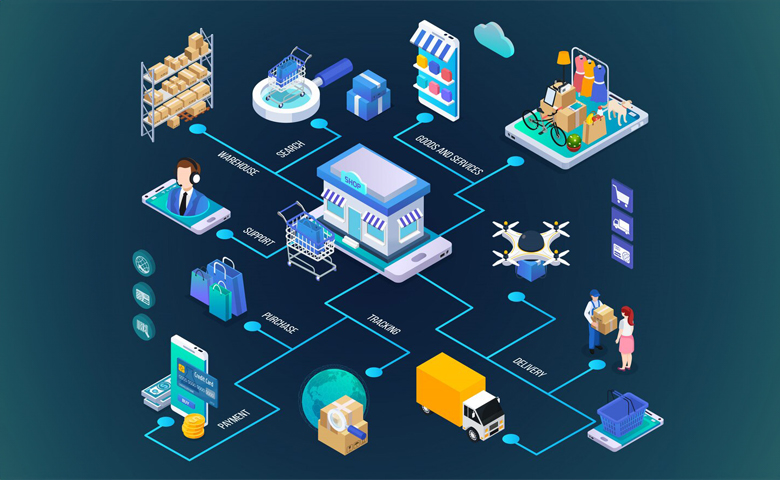A checklist for intelligent automation in retail
By Retail4Growth Bureau | July 15, 2024
Rishi Jyoti, Vice President – Retail, CPG & Manufacturing, Sonata Software, shares his insights on transforming the retail business with intelligent automation to maximize impact, in this exclusive column for Retail4Growth.

At a time where physical and digital realms intertwine, the retail industry is undergoing a significant transformation in its operational paradigm. The increasing amount of data, massive digital footprints, smart supply chain management, and shifting customer behavior all contribute to this progression. Intelligent Automation and RPA (Robotic Process Automation) are transforming the retail sector by improving productivity, automating repetitive work, and allowing for a more focused attention on long-term goals.
According to Deloitte Insights, 72% of retail organizations expect to implement or extend their usage of RPA in the next two years, demonstrating the growing recognition of RPA's usefulness among retailers. RPA's capacity to optimize processes, cut expenses, and enhance customer satisfaction makes it an indispensable instrument for businesses striving to maintain their competitive edge.

Here are key five steps, which retail organizations can adopt to ensure a successful RPA implementation.
Discerning Which Processes to Automate
Numerous opportunities arise from automation, but it's crucial to determine which procedures warrant it. Retailers should focus on high-volume, repetitive tasks that adhere to rules. Automating processes for stock replenishment in inventory management, for instance, ensures optimal stock levels, reduces the possibility of human error and lessens the likelihood of out-of-stock situations. Order entry, invoicing, and payment processing can all be automated to speed up order fulfilment and reduce errors. This can also be quite beneficial for order processing. Additionally, customer service can be enhanced, leading to faster response times and higher customer satisfaction, by utilizing chatbots and automated response systems to solve common client complaints. These benefits were realized for a well-known online shop when they used RPA for inventory management. It tracked stock levels constantly and generated purchase orders on its own when inventories dropped.
Devising a Game Plan
Conducting a thorough assessment to determine which operations will benefit most from automation is an essential first step for organizations considering RPA. Involve important stakeholders from all departments to guarantee cross-functional viewpoints and group support, and select the ideal RPA platform and vendor size to complement particular requirements and current IT architecture. A retail chain, for instance, can drive massive efficiencies by working with cross-functional teams to find supply chain bottlenecks, expedite delivery times and streamline logistics by right level of automated communication between multiple parties and systems.
Setting a Deployment Timeline
Setting up a practical schedule for RPA implementation is essential. A staggered rollout that progressively broadens the scope of automation, a pilot program to test the waters and spot possible problems, and ongoing improvement through frequent assessments and adjustments based on input and performance metrics are all essential components. One of the leading multinational fashion retailers started an RPA trial to automate their returns procedure. They reduced the return processing time by 50% by scaling the automation across all of their stores following a successful pilot.
Assessing the Impact of RPA
Examine this use case: A department store chain uses RPA for customer service after thorough consideration and planning. After examining the performance data, they discovered that, in comparison to manual processing, automated customer care queries were addressed 40% faster, which significantly raised customer satisfaction ratings. This demonstrates very well the effects of efficient RPA in relation to return on investment. To determine RPA's efficacy, impact measurement is crucial. Efficiency increases, cost savings, accuracy improvements, and customer satisfaction are a few of the important measures. The amount of time saved on automated processes can be used to quantify efficiency gains, and the amount of money saved can be determined by lowering labor and operating costs. Customer satisfaction is measured by improvements in customer service metrics and feedback, while accuracy improvements are monitored by a decrease in errors and rework.
Governance and Compliance
With so many bots in the mix, RPA can go rogue if left unchecked, despite its enormous potential. Strong governance is essential to the long-term viability of RPA projects in the retail industry. For retailers handling credit card transactions, this entails abiding by industry-specific laws and guidelines, such as the Payment Card Industry Data Security Standard (PCI DSS). By ensuring that consumer credit card data is handled, stored, and sent securely, compliance with PCI DSS lowers the risk of fraud and data breaches. Retailers may protect sensitive consumer data and uphold credibility and confidence with their customers by putting in place RPA solutions that adhere to PCI DSS rules. Creating a thorough change management strategy is equally important to assist staff members in adjusting to automated procedures. The retail organization may cultivate a culture of innovation and adaptation by empowering teams, easing fears, and implementing training programs and transparent engagement initiatives. Setting governance and compliance procedures as a top priority guarantees that RPA projects comply with laws and industry norms, which enhances the general prosperity and long-term viability of the retail industry.
RPA has immense potential to transform the retail industry from the ground up by boosting customer delight, reducing costs, and increasing productivity. Real-world examples illustrate the measurable advantages that RPA can offer, making it a vital tool for companies attempting to maintain their competitiveness in an increasingly digital marketplace. When used correctly, RPA may generate economies of efficiency, freeing up human intelligence for use in strategic endeavors. By putting the aforementioned procedures into place, retail organizations can discover the revolutionary potential of RPA and create more adaptable, effective, and customer-centric operations.
Pic courtesy: https://www.freepik.com

_165_265.jpg)
_165_265.jpg)


_140_270.jpg)



Comments